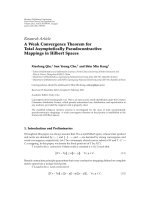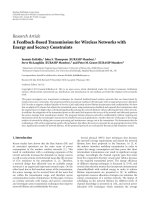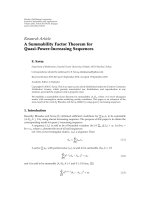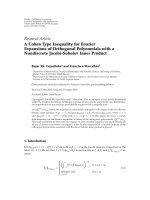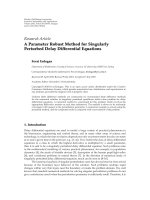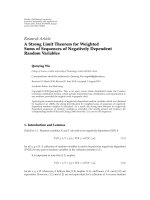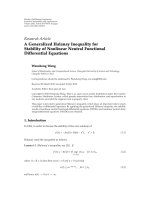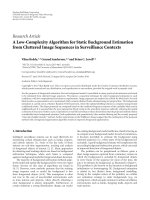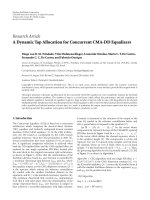Báo cáo hóa học: " Research Article A Potential Transmitter Architecture for Future Generation Green Wireless Base Station" potx
Bạn đang xem bản rút gọn của tài liệu. Xem và tải ngay bản đầy đủ của tài liệu tại đây (2.3 MB, 8 trang )
Hindawi Publishing Corporation
EURASIP Journal on Wireless Communications and Networking
Volume 2009, Article ID 821846, 8 pages
doi:10.1155/2009/821846
Research Article
A Potential Transmitter Architecture for
Future Generation Green Wireless Base Station
Vandana Bassoo,
1
Kevin Tom,
1
A. K. Mustafa,
1
Ellie Cijvat,
2
Henrik Sjoland,
2
and Mike Faulkner
1
1
Centre for Telecommunications and Micro-Electronics, Footscray Park Campus, Victoria University,
P.O. Box 14428, 8001 Melbourne, Australia
2
Department of Electrical and Information Technology, Lund University, Sweden
Correspondence should be addressed to Vandana Bassoo,
Received 30 March 2009; Accepted 14 August 2009
Recommended by Naveen Chilamkurti
Current radio frequency power amplifiers in 3G base stations have very high power consumption leading to a hefty cost and
negative environmental impact. In this paper, we propose a potential architecture design for future wireless base station. Issues
associated with components of the architecture are investigated. The all-digital transmitter architecture uses a combination of
envelope elimination and restoration (EER) and pulse width modulation (PWM)/pulse position modulation (PPM) modulation.
The performance of this architecture is predicted from the measured output power and efficiency curves of a GaN amplifier. 57%
efficiency is obtained for an OFDM signal limited to 8 dB peak to average power ratio. The PWM/PPM drive signal is generated
using the improved Cartesian sigma delta techniques. It is shown that an RF oversampling by a factor of four meets the WLAN
spectral mask, and WCDMA specification is met by an RF oversampling of sixteen.
Copyright © 2009 Vandana Bassoo et al. This is an open access article distributed under the Creative Commons Attribution
License, which permits unrestricted use, distribution, and reproduction in any medium, provided the original work is properly
cited.
1. Introduction
The existing third generation network deployed around the
world is not sufficient to meet the needs of new upcoming
bandwidth intensive applications. It is expected that by
2012, two-thirds of the estimated 1.8 billion broadband
users will be connected through a wireless device [1].
A fourth generation wireless system will be required to
transmit higher bit rates to more users in a more flexible
way. This will lead to higher transmission bandwidths and
greater transmission powers. Transmission efficiencies must
therefore increase if the equipment is to be housed in
existing shelters, using existing cooling (air-conditioning)
and existing power sources.
Mobile operators around the world are becoming
increasingly interested to reduce their operating costs and
carbon footprint. Developing countries are particularly
susceptible because of the low income of their subscribers.
Therefore, base station manufacturers around the world
are looking for solutions to develop “greener” and efficient
technology. The goal here is to replace the power connection
(or diesel generator in developing countries) with solar
cells. This is only practical if the overall basestation power
consumption can be reduced to realistic levels. At present,
the radio frequency power amplifier (PA) is the largest power
usage component, accounting for approximately 30%–40%
of a 3G wireless base station’s total consumption. High
power usage leads to higher costs and an unacceptable
environmental impact.
Efficient multicarrier schemes such as orthogonal fre-
quency division multiplexing (OFDM) are required to
cater for the increasing transmission bandwidths. OFDM
signals require conventional linear PAs. A tradeoff between
efficiency and linearity always exists in PA design. A typical
feed-forward class AB PA has efficiency in the range of 10%
with modulated signals. Alternatively, a class E switched
mode PA has the potential to attain drain efficiencies of up
to 45% when operated with 8 dB peak to average Rayleigh
enveloped signal [2]. Switch mode power amplifiers (SMPAs)
are highly nonlinear and attain maximum efficiency if driven
2 EURASIP Journal on Wireless Communications and Networking
by a pulse waveform. The challenge is on the modulation
stage to generate the appropriate drive signal which is
optimised for efficiency and linearity. This has lead to a
renewed interest in architectures such as linear amplification
with nonlinear components (LINCs), envelope elimination
and restoration (EER), and pulse width modulation (PWM)
[3–5]. This paper considers a combined EER and PWM
amplifying scheme.
The continuing improvement in silicon technology is
enabling digital circuits to operate at higher frequencies
suggesting that direct digital generation of the amplifier’s
RF drive signal is now possible. Figure 1(top) shows the
traditional wireless base station architecture and a proposed
architecture (Figure 1(bottom))forafuturegenerationof
wireless base stations using SMPAs (e.g., classes D and E).
The new architecture eliminates most analog components in
the driver circuit. These include digital to analog converters
(DACs), reconstruction filters, the local oscillator, and the
quadrature modulator. The new all-digital architecture can
thus be easily integrated on chip.
The EER-driven PA architecture, Figure 1(middle), has
a theoretical efficiency of 100% and operates by splitting
the signal into polar components (envelope and phase). The
envelope, u, controls the SMPA supply and the phase, s,
controls the pulse position modulator of the input pulses
which form the RF drive signal. This is a constant envelope
modulated signal that keeps the amplifier operating in its
most efficient saturated mode. However, this structure suffers
from bandwidth expansion when used with OFDM signals.
OFDM is a noise-like signal with a random path in the
I and Q plane, any near zero crossings cause large dips
in the envelope signal and a large rate of phase change
(instantaneous frequency) for the phase drive signal. The
coordinate transform of the OFDM signal from Cartesian
to polar therefore results in envelope and phase components
that have wider bandwidths than that of the input signal.
Unfortunately, the bandwidth of the polar envelope compo-
nent cannot be too high since sharp dips in the magnitude
cannot easily be reproduced by the switch mode DC-
DC converter. We therefore propose a technique to reduce
the envelope’s bandwidth expansion without distorting the
output signal (Figure 1(bottom)). Bandwidth reduction is
possible by allowing some amplitude variation in the phase
signal, s, driving the amplifier. The amplitude variation can
be impregnated onto the phase modulated pulse position
modulation (PPM) signal, s
ΣΔ
, by applying pulse width
modulation (PWM) on the PPM pulses of the input RF drive
signal (Figure 2). This maintains the all-digital architecture.
If synchronous digital circuits are to be used the pulse edges
must occur on the timing grid of the digital clock. This limits
the selection of possible pulse positions and pulse widths
leading to time quantisation. Sigma delta (ΣΔ)converters
can generate the two state PWM/PPM signal, while shaping
the time quantisation noise away from the band of interest.
In this paper, we measure the output power and efficiency
of a GaN single stage amplifier and from these results
we then predict the performance of the amplifier in the
new architecture. We show there is a tradeoff between
amplifier efficiency and the bandwidth of the envelope
component. Section 2 compares the efficiency of a GaN
amplifier operating in two modes; the first mode uses an
approximate PWM gate drive signal and the second mode
uses a high level EER drive on the V
dd
supply line. Section 3
introduces a new technique for bandwidth reduction of the
polar envelope drive signal and then predicts the efficiency
based on the amplifier measurements. Section 4 discusses the
use of (ΣΔ) to generate a suitable amplifier input pulse train
with phase and amplitude information encoded in its pulse
width and pulse position. Section 5 concludes by discussing
the viability of the new architecture.
2. Switch Mode Power Amplifier
In this section, we predict from measurements an amplifier’s
performance in two operating modes. The first mode uses
a PWM [6] drive signal and the second mode uses the
more conventional polar EER drive signals. The operating
frequency of the power amplifier is designed to be 400 MHz.
A discrete GaN HEMT device is chosen because it has good
gain at high power and a lower drain-source capacitance
than competing LDMOS devices which should make it more
suitable for high efficiency in switch-mode operation [7].
2.1. PA with PWM Drive and EER Drive. A simple way
to obtain PWM operation is to use a comparator and a
triangular drive signal with the reference input controlled by
the envelope modulation (Figure 3). In this work the PWM
signal is directly generated in the output power device to
avoid the need for special wideband input matching circuits.
The amplifier input is overdriven with the phase modulated
sinusoidal carrier signal (V
p
), and the gate bias (V
bias
)is
controlled by the envelope component of the modulated
signal. Since the device threshold voltage (V
T
)isfixed,
this has the effect of varying the on/off duty cycle of the
amplifier, as illustrated in Figure 4. The PWM like signal
at the drain of the device has a slightly reduced slew rate
because of the limited gain of the device. Also, the pulse
width is no longer linear with respect to the envelope signal,
ΔV
= (V
T
−V
bias
), because of the nontriangular drive signal.
The latter indicates the need for linearisation. The output
tuning network provides filtering of the pulsed drain signal
and performs the impedance transformation from the load
impedance to the drain of the device. The output and input
networks were optimised for a range of pulse widths by
simulation using the harmonic balance method of ADS [6].
The same amplifier configured as an EER PA structure is
shown in Figure 5. Here the low frequency envelope signal
modulates the PA supply (V
dd
).
2.2. Measurement Results. The full amplifier including
matching networks is implemented using surface mount
components on a standard FR4 PCB, with double sided
copper layers as illustrated in Figure 6. The inductor at the
drain of the device is implemented using a transmission
line. The device is a CREE CGH40010 discrete GaN HEMT
device suitable for high output power (10 W), high efficiency
(60%), and high frequency (6 GHz) operation. The threshold
EURASIP Journal on Wireless Communications and Networking 3
Linear
PA
Filter
LPF
DAC
Digital
predistortion
Q
I
DAC
LPF
IQ
mod
Tx
Lo
BPF
BPF
SMPA
SMPA
Cartesian to
polar
Signal
conditioning
PPM
Switch mode DC-DC
modulator
Switch mode DC-DC
modulator
Q
I
Q
I
s
u
s
s
ΣΔ
u
ΣΔ drive
PWM/PPM
Figure 1: Traditional (top), EER (middle), and proposed (bottom) transmitter architectures.
Wavef or m
after PPM
Reference
waveform
Wavef or m
after PWM
Figure 2: Demonstrating PWM (amplitude modulation) and PPM
(phase modulation) concept. Edges occur on the digital timing grid.
voltage is −2.5 V, and the nominal supply voltage is 28 V [7].
The carrier frequency was 395 MHz and a high-power input
signal was used (23 dBm), since the PA was to operate in
switch-mode.
In Figure 7(a), the efficiency and output power as a
function of V
bias
are shown. The figure shows that the useful
range of gate bias voltage is roughly 4 V, from
−5Vto−1V.
This results in an output power variation from 19 dBm to
39.6 dBm, and a drain efficiency variation from 6% to 61%.
The loss of efficiency at low output powers is consistent
with PWM operation, where slew-rate losses are essentially
constant whatever the pulse width (output power).
The EER architecture was not assembled fully, but
measurements were made on the PA varying the supply
voltage (V
dd
) and keeping the gate bias voltage constant. The
efficiency and output power are plotted in Figure 7(b). V
dd
+
−
Envelope
(a)
Phase
Envelope
(b)
Figure 3: PWM generation: (a) ideal, (b) PA schematic.
V
p
V
T
V
bias
ΔV
On
Off
Figure 4: Operating principle of the power amplifier. The difference
ΔV between V
bias
and V
T
varies, depending on V
bias
and the
resultant PWM drain signal is illustrated.
4 EURASIP Journal on Wireless Communications and Networking
Phase
Envelope
Figure 5: EER architecture.
V
bias
Transmission
line
RF
output
RF
input
Figure 6: The PCB with the transmission line inductance and I/O
ports indicated.
scales the output signal, for example, doubling the supply
voltage will increase the amplifier’s output by 6 dB.
Comparing the efficiency performance of both the PWM
and EER PA architectures, it can be noticed that with
the PWM structure the efficiency holds good only over a
small dynamic range, within less than 3 dB of peak output
power. Therefore, to maintain high efficiency the amplitude
variation needs to be small. On the other hand, the EER
structure maintains efficiencies above 60% over a wide
dynamic range (18 dB). Figure 8 restates the measured results
in a way that gives a more insightful comparison. The plot
shows the efficiency versus normalised output power for
both architectures. The power is normalised to the amplifier’s
peak output power; in this case 39.6 dB for V
dd
= 30 V. The
dotted PWM curve is for measurement data with V
dd
=
10 V. It has the same basic shape as the V
dd
= 30 V curve,
except for a small efficiency scaling due to the improvement
in efficiency at lower V
dd
’s (Figure 7(b)). The similarity
between the normalised V
dd
curves will be used later in the
paper to calculate the expected efficiency of amplifiers using
a combination of PWM and EER modulation.
Although, the EER architecture gives better efficiency
with modulated signals it still requires a supply modulator,
commonly implemented as a class-S amplifier. The switching
frequency of the supply modulator must be considerably
larger than the envelope bandwidth to minimise distortion;
this increases the switching losses when the bandwidth is
P
out
Efficiency
−5 −4.5 −4 −3.5 −3 −2.5 −2 −1.5 −1
V
gs
(Volts)
0
10
20
30
40
50
60
70
P
out
(dBm) and efficiency (%)
(a)
P
out
Efficiency
51015202530
V
dd
(Volts)
0
10
20
30
40
50
60
70
P
out
(dBm) and efficiency (%)
(b)
Figure 7: Measurement results. Output power and drain efficiency
for (a) PWM-like operation and (b) EER operation.
high. Therefore, a suitable bandwidth limitation scheme
needs to be applied to the envelope component in order to
maintain the supply modulator efficiency. The next section
describes the trade-off between envelope bandwidth and
amplifier efficiency.
3. Bandwidth Limitation
In the EER architecture, Figure 1(middle) generates the
envelop signal for the DC to DC converter and a constant
amplitude phase modulated signal for the amplifier input
RF drive. The coordinate transform from Cartesian to polar
results in signal components that have wider bandwidth than
that of the original input signal. We propose a technique
to reduce the bandwidth expansion of the envelope polar
drive signal by using both EER and PWM/PPM modula-
tion as shown in Figure 9. The amplifier effectively scales
EURASIP Journal on Wireless Communications and Networking 5
00.10.20.30.40.50.60.70.80.91
Normalised P
out
0
10
20
30
40
50
60
70
Efficiency (%)
Figure 8: Efficiency against power output. PWM curves are for V
dd
= 30 V (solid) and for V
dd
= 10 V (dashed) and EER (solid).
(multiplies) the PWM/PPM output by the instantaneous
V
dd
.
The process first limits the envelope bandwidth, R,ina
low pass filter and then adds a DC offset to stop clipping
at the amplifier. The u
= R
+ dc signal acts as the
supply modulator for the amplifier. The phase information
is obtained by dividing the input signal with u.Here,
s
= x/(R
+ dc) is the drive signal for the PA. The ΣΔ
operation converts the magnitude/phase information of s
into an equivalent PWM/PPM pulse driver signal s
ΣΔ
for
the amplifier. In the case of no bandwidth limitation (i.e.,
LPF bandwidth
= ∞Hz), the input drive, s, is a constant
magnitude signal containing phase information only. The
architecture then works as EER. On the other hand, if there
is full bandwidth limitation (LPF bandwidth
= 0 Hz), u
contains only a fixed DC value and s is the original input
signal, x. Limiting the envelope bandwidth and allowing
some envelope variation into the phase drive signal, s,result
in reduced bandwidth expansion for both envelope and
phase drive signals. The input drive, s, is scaled multiplied
by the envelope signal, u, within the amplifier to recreate, x,
at the amplifier output.
Figure 10 shows the spectra of the OFDM RF signal,
x, and its polar drive components s and R. The effect of
envelope bandwidth limitation is shown with and without
compensation of the phase drive signal. The thin solid
lines show the RF and polar components, when there is no
bandwidth limitation. This is the EER condition and clearly
shows the bandwidth expansion of the envelope and input
signals.
The dashed line, x, shows the blow out of the RF spec-
trum when the envelope (R
, shown dotted) is bandwidth
limited, to one OFDM channel without applying the corre-
sponding compensation. Adjacent channel power exceeding
−40 dBc will exceed the spectrum transmission mask for
most standards (WLAN@
−40 dB and UMTS@−50 dB). The
OFDM inband signal is also affected by a build up in error
vectormagnitude(EVM);butatalevelof
−38 dB, this is
unlikely to cause a problem. When compensation is applied
to the input signal, s, its bandwidth reduces (Figure 10
dotted), and the blowout in the RF spectrum is repaired,
as is the EVM. The new architecture leads to envelope and
input bandwidths being reduced to 28% of the original
EER bandwidths, when measured at a
−50 dB threshold.
Even though the RF signal suffers no EVM or adjacent
channel interference (ACI), when the envelope bandwidth
is limited, the amplifier efficiency is compromised. We use
the measured curves of Figure 8 to predict the amplifier
efficiency when it passes an OFDM signal. This noise-like
signal has a wide dynamic range and in the simulations
amplifier clipping occurs when R
+ dc < |x|,orif|s| > 1.
Low DC values increase clipping but are best for efficiency.
For each bandwidth limit we choose the DC value to give the
same clipping energy as a normal OFDM signal clipped to
8 dB PAPR (peak to average power ratio). The clipping noise
for each simulation is therefore the same.
Figure 11 shows the predicted efficiency versus envelope
bandwidth plots for OFDM modulation. When there is no
envelope bandwidth limitation the amplifier structure works
as EER and the efficiency is at 62%. However, when the
bandwidth limitation is at 0 Hz, that is, the envelope has
only a fixed dc value, the efficiency is at 28% which is the
efficiency of the PWM amplifier by itself. A further 10%
efficiency can be gained with the envelope filtered to 0.25
channel bandwidths. The optimal point lies at the knee of
the curve at 0.75 channel bandwidths which yields a 57%
efficiency.
4. Pulse Train Generation Using
Sigma Delta Modulation Technique
Figure 12 shows the block diagram of an architecture
proposed in [8]whichwerefertoasCartesianΣΔ.It
can generate a PWM/PPM pulse train with the appropri-
ate phase and amplitude information, while having full
compatibility with synchronous digital circuit design. It
consists of two first-order lowpass sigma delta modulators
(MOD 1 [9]), amplitude and a phase quantisers, and a
polar to “PWM/PPM” block. The Cartesian signals pass
through ΣΔ filters, after which they are converted to polar
[R, θ] for quantisation in blocks Q
R
and Q
θ
. The quantised
signals [
R,
θ] are then reconverted to Cartesian before being
fedbacktotheΣΔ filters. ΣΔs shape the quantisation
noise away from the signal band. The previous reported
structures perform ΣΔ filtering on the polar signal [10],
while this work gives superior performance because the
ΣΔ filtering is on the Cartesian signal where there is no
bandwidth expansion. The equations from [11]areusedto
decide the amplitude threshold levels as the quantisation is
performed in the polar domain. In this case, the amplitude is
quantised into (n/2 + 1) levels corresponding to pulse widths
(0, 2/n,4/n,6/n
···(n/2)/n)(1/f
c
)(f
c
= carrier frequency)
and the phase is quantised into n phase increments from zero
to 2π. This quantisation process requires the system digital
clock to oversample f
c
by a factor of n ( f
clock
= nf
c
).
6 EURASIP Journal on Wireless Communications and Networking
OFDM
Cartesian to
polar
BW limit
dc
+
x
R
ΣΔx/(R
+ dc)
u
= R
+ dc
clk
s
ΣΔ
s
x
= u
∗
s
Figure 9: The new transmitter architecture. The ΣΔ clk operates at the carrier frequency and gives an amplitude and phase output for each
RF cycle.
s
R
x
00.511.522.53
Relative BW
−50
−40
−30
−20
−10
0
Power (dB)
BW =∞
EER RF out (x)
EER envelope (R)
EER phase (s)
BW
= 1
RF out (BW limited envelope)
BW limited envelope (R
)
Compensated phase (s)
Figure 10: Spectra of the input drive signal, s, envelope signal, R,
andRFsignal,x.
00.511.5
Envelope BW (channels)
30
40
Efficiency (%)
Figure 11: Average efficiency versus envelope bandwidth for an
OFDM signal.
The “polar to PWM/PPM” block is responsible for
upconverting the output of the quantisers to RF. The
quantised phase,
θ, determines the pulse position and the
quantised amplitude,
R, determines the pulse duration [8].
The output of the “polar to PWM/PPM” block is a pulse
train to be fed to the switch mode PA and band-pass filtered
to eliminate quantisation noise and out-of-band distortion
products.
A simulated OFDM signal was used to test the system
described. In the spectral domain, the noise in the adjacent
channels needs to be below an acceptable level. The out-of-
band distortion products are measured by calculating the
adjacent channel power (ACP) ratio, defined as the noise
power in the adjacent channel over signal power. Figure 13
shows a spectrum plot of the Cartesian sigma delta at an
input power of
−7 dB. ACP1 indicates the first adjacent
channel and ACP2 indicates the second adjacent channel.
The shaping effect of the ΣΔ filters can be observed from the
gradual increases in noise power as we move away from the
band of interest. The output band-pass filter will limit any
unwanted noise far away from the desired band.
Since the oversampling factor, n, has a direct impact on
possible carrier frequencies, it is crucial to keep n as low
as possible. Figure 14 shows a plot of ACP versus n.The
appropriate n can be chosen depending on the spectrum
mask of the standard. The Cartesian ΣΔ clearly outperforms
the polar ΣΔ, leading to a lower n requirement for the same
ACP. The results shown here for n
= 4 are reasonable for
the WLAN standard (ACP <
−40 dB). However a higher
oversampling rate of n
= 16 is required to meet the tougher
−50 dB WCDMA spectrum mask, limiting f
c
to about
200 MHz using current digital technology ( f
clock
= 3.2 GHz).
Clock rates must further improve before carrier frequencies
in the cell phone bands can be handled.
5. Conclusion
Ahighefficiency all-digital transmitter architecture that
uses a combination of EER and PWM/PPM modulation is
described. We predicted the performance of this architecture
from the measured output power and efficiency curves of a
GaN amplifier. An OFDM signal limited to 8 dB PAPR will
give 57% efficiency which compares favourably to the peak
amplifier efficiency of 64% with a continuous wave signal
(Figure 7).
A number of challenges still exist before a high efficiency
all-digital transmitter can be realised at high carrier frequen-
cies. From the amplifier perspective parasitic capacitances
will always limit the efficiency of the PWM/PPM mode,
since the wide bandwidths of switching waveforms make
resonating out unwanted capacitances somewhat difficult.
The situation should improve at lower carrier frequencies.
The EER mode has excellent efficiency for most amplifier
EURASIP Journal on Wireless Communications and Networking 7
ΣΔ filter
Polar
to
PWM/
PPM
P
to
C
C
to
P
R
ΣΔ filter
R
Q
R
Q
θ
θ
θ
Q
I
SMPA BPF@ f
c
1/(nf
c
)
I
Q
f
s
= 2f
c
Figure 12: Block diagram of cartesian sigma delta.
ACP1
ACP2
850 900 950 1000 1050 1100 1150 1200
Frequency
−60
−50
−40
−30
−20
−10
0
Average spectrum
Figure 13: Spectrum plot of Cartesian sigma delta, n = 16, f
c
=
1024 MHz, OFDM channel bandwidth = 20 MHz.
0 5 10 15 20 25 30
Oversampling factor, n
−55
−50
−45
−40
−35
−30
−25
−20
ACP (dB)
Polar ΣΔ
Cartesian ΣΔ
ACP1
ACP2
Figure 14: Plot of ACP (dB) against oversampling rate, n. The first
and second adjacent channels are shown.
classes, and the amplifier described here is no different.
The major limitation of EER is the envelope bandwidth.
We have not considered the DC/DC converter in this
work, but we have shown that most of the EER efficiency
can be conserved if the envelope bandwidth is limited
to no less than 0.75 channel bandwidths. The ACI and
EVM distortion that this causes in the RF output can
be removed by varying the amplitude (in this case using
PWM) of the phase modulated input drive signal. Further
reduction in the envelope bandwidth requires the PWM
waveform to have high efficiency over a greater dynamic
range.
The PWM/PPM amplifier drive signal can be directly
formed from the I and Q digital baseband signals using ΣΔ
techniques to mitigate time quantisation of the pulse edges.
The improved performance of the Cartesian filtering in the
ΣΔ enables coarser time quantisation of the RF carrier signal.
Even so, the digital clock must oversample the RF carrier
by a factor of four to meet the WLAN spectral mask and
by at least a factor of sixteen to meet the more demanding
WCDMA specification. Even though the CREE amplifier is
good to 6 GHz [7], it is the digital modulating circuits that
limit the maximum carrier frequency.
References
[1] Ericsson, “Sustainable energy use in mobile communications,”
August 2007, />mobile communications/downloads/sustainable energy.pdf.
[2]K.Tom,M.Faulkner,andT.Lejon,“Performanceanalysis
of pulse width modulated RF class-E power amplifier,” in
Proceedings of the IEEE 63rd Vehicular Technology Conference
(VTC ’06), vol. 4, pp. 1807–1811, Melbourne, Australia, May
2006.
[3] A. Diet, C. Berland, M. Villegas, and G. Baudoin, “EER
architecture specifications for OFDM transmitter using a class
E amplifier,” IEEE Microwave and Wireless Components Letters,
vol. 14, no. 8, pp. 389–391, 2004.
[4] C. Berland, I. Hibon, J. F. Bercher, et al., “A transmitter
architecture for nonconstant envelope modulation,” IEEE
Transactions on Circuits and Systems II, vol. 53, no. 1, pp. 13–
17, 2006.
8 EURASIP Journal on Wireless Communications and Networking
[5] F. Wang, D. F. Kimball, J. D. Popp, et al., “An improved power-
added efficiency 19-dBm hybrid envelope elimination and
restoration power amplifier for 802.11g WLAN applications,”
IEEE Transactions on Microwave Theory and Techniques, vol.
54, no. 12, pp. 4086–4099, 2006.
[6] E. Cijvat, K. Tom, M. Faulkner, and H. Sjoland, “A GaN HEMT
power amplifier with variable gate bias for envelope and phase
signals,” in Proceedings of the 25th IEEE Norchip Conference
(NORCHIP ’07), pp. 1–4, Aalborg, Denmark, November 2007.
[7] Cree Inc., “CGH40010 product specification,” e
.com/products/pdf/CGH40010.pdf.
[8] V. Bassoo and M. Faulkner, “Sigma-delta digital drive signals
for switch-mode power amplifiers,” Electronics Letters, vol. 44,
no. 22, pp. 1299–1300, 2008.
[9] R. Schreier and G. C. Temes, Understanding Delta-Sigma Data
Converters, Wiley-IEEE Press, New York, NY, USA, 2004.
[10] J. Keyzer, R. Uang, Y. Sugiyama, M. Iwamoto, I. Galton,
and P. M. Asbeck, “Generation of RF pulsewidth modulated
microwave signals using delta-sigma modulation,” in Proceed-
ings of the IEEE MTT-S International Microwave Symposium
Digest, vol. 1, pp. 397–400, Seattle, Wash, USA, June 2002.
[11] P. Wagh and P. Midya, “High-efficiency switched-mode RF
power amplifier,” in Proceedings of the 42nd Midwest Sym-
posium on Circuits and Systems, vol. 2, pp. 1044–1047, Las
Cruces, NM, USA, 1999.
